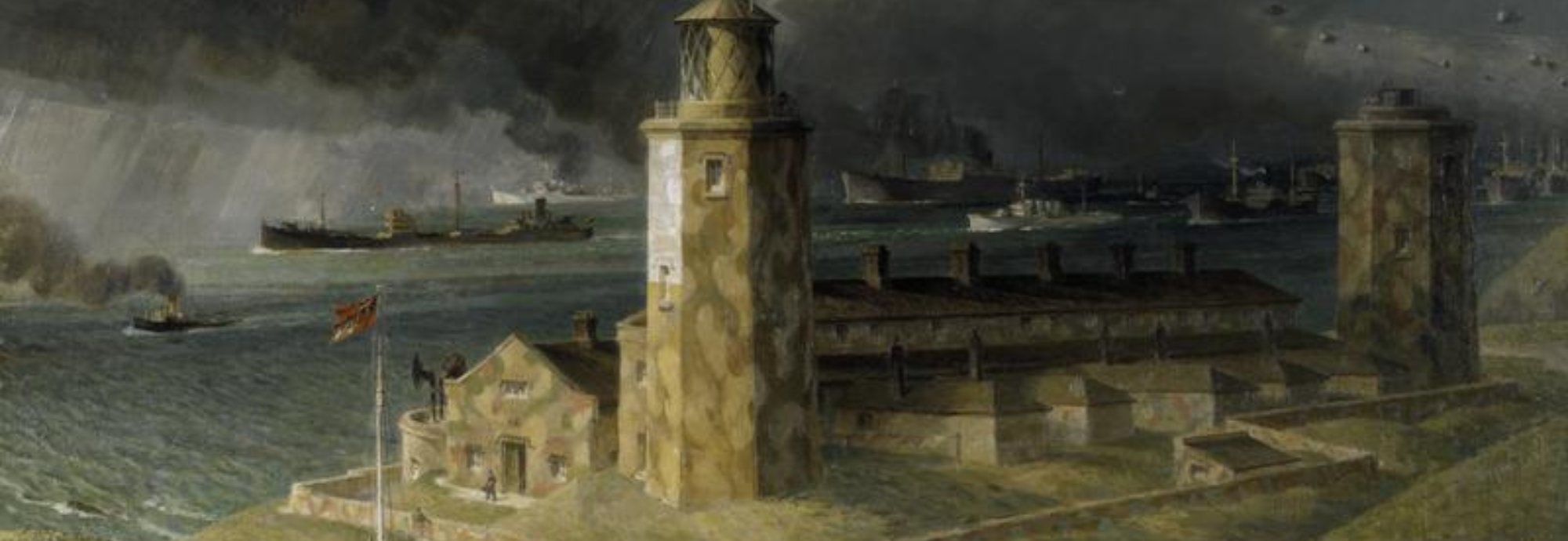

By Linda Batchelor
In 1806 Commander Robert Pettet of the Royal Navy’s HMS Termagant, on convoy duty in the Mediterranean, sent a letter to the Company of Merchants at Lloyd’s in London. The letter testified his thanks to Captain William Broad of Falmouth, master of the merchant vessel Phoenix, the guide ship in a convoy from Smyrna on a passage through the Mediterranean to Malta and Gibraltar, for “the very great exertions he used during the whole of that passage, not only by answering and repeating my signals, but by taking such vessels of the convoy in tow that at any time happened to be sternmost”.
Two years later Commander John Bowen of HMS Camilla also wrote to Lloyd’s to praise the conduct and help that Captain Broad of the Phoenix had rendered in convoy.

HMS Camilla. John Thomas Serres (1759 -1825).
Ships sailing alone, particularly merchant vessels, can be vulnerable to attack by pirates, privateers or enemy vessels so a convoy provides safety in numbers and protection if accompanied by armed ships. Convoys provide greater security, especially in hostile situations such as revolt or war, and ensure that supply chains remain in place both in terms of goods and personnel. The greater security is also important to insurers, which explains Commander Pettet’s assurance to Lloyd’s that Captain Broad’s conduct “must meet your appreciation”.
During the years 1803 to 1815 Britain was involved in war with France both on land and at sea. In 1806 HMS Termagant was a Royal Navy warship on the Mediterranean Station on convoy duty. In such hostile times British merchant vessels were open to attack at sea from enemy ships and French and Spanish privateers and this convoy of valuable merchant ships were sailing under the protection of the British warship. It was during this period in the latter 18th and early 19th centuries that the Royal Navy refined the formal rules of convoy management.
The Admiralty issued the orders for convoys although in some foreign ports this function was undertaken by senior navy officers. The Admiralty also issued printed copies of Signals and Instructions for Ships Under Convoy. The commander of a convoy’s naval escort was then required to issue sailing orders and instructions to any master of a British flag merchant ship. The instructions included details of signals required for day, fog and night sailing, the order of sailing and the stipulation that in ‘case of threat of being boarded or taken possession the captain must destroy all instructions confided in him relating to the convoy.’
William Broad was a highly skilled and valued merchant commander. The master of merchant vessels sailing from Truro and Falmouth, he was a member of the Levant Company involved in trade with the Mediterranean and Middle East. Salt cured pilchards were shipped from Cornwall to Italy and the ships returned with oil, dried fruit and spices from Smyrna (now Izmir in Turkey), one of the Levant Company’s trading hubs known as factories.
Convoy duty was not always an easy task for the escorting Royal Navy with the variety of vessels and the independent nature of merchant masters and their crews. In a letter of 1781 Nelson remarked that some merchant ships in convoy behaved ‘shamefully ill’. Captain Broad was relied upon by his Royal Navy escorts in convoy for his skill as a seaman and his ability to command. His vessels such as Pelican and Phoenix were invariably selected as guide or repeating ships in convoys. The duty of a guide ship is to maintain the accuracy of the course and of the speed ordered and to reinforce command. A guide ship is also designated to relay (repeat) messages usually by flag or flashing lights from the convoy commander to other ships in the convoy. For his assistance and reliability as commander of a repeating ship Captain Broad was entitled to fly a pennant on his vessel to indicate its status and his crews were exempt from impressment.
The Impress Service was designed to supplement voluntary recruitment by the compulsory ’taking’ of men for service in the Royal Navy’s warships. Press gangs made up of a naval Lieutenant and about ten sailors were issued with press warrants enabling them to take men legally for that purpose. As well as the official press service gangs operating in ports around Britain individual ships sometimes sent out their own gang to supplement crew. Merchant seamen were particularly at risk of impressment, especially after individual ships and convoys returned to their home ports, so the protection afforded to William Broad’s crews was an asset for both the men and the master.
The concept of ships sailing together in convoy has a long history but it was the Spanish who employed and developed the concept to the full during the 16th Century. As the Spanish Empire expanded in the Americas the need to protect their treasure fleets sailing between Europe and the New World from marauders became paramount. From the 1560s these ships plying the Atlantic began sailing in convoys in two sea lanes from Seville. The convoys protected by armed galleys were composed of general purpose cargo fleets carrying goods between Spain and the Spanish territories. On the return voyages the convoys transported treasures from those territories such as gold, silver, gems and pearls, spices, sugar, silk and tobacco.
As other European powers such as the English, Dutch and French, also extended their overseas territories possession of sea routes became vital. Political and commercial expansion meant that rivalry grew between nations and it became important to maintain control of sea lanes to protect trading and supply routes. Convoys were often used as protection for merchant ships sailing to and from the Levant, the Americas and Caribbean, Africa and the East Indies.
The protection could be against threats by pirates, such as Barbary pirates who threatened the Levant trade in the Mediterranean, or in times of hostilities or war from privateers or enemy naval vessels. In some instances protection was provided by armed merchantmen from the trading companies such as the English and Dutch East India Companies and at others by warships of national navies. Even in non-hostile times the use of convoys has been and still is an important aspect of seaborne shipping.
Control of the seas and protection of trade became the heart of British naval strategy. Naval convoy escort duties were first defined in the Anglo-Dutch Wars of the latter 1600s. It was during the period in the latter 18th and early 19th Century, in conflicts of the American and French Revolutionary Wars and the Napoleonic War, that the Royal Navy refined the formal rules of convoy management. In the ensuing years these rules have been relied upon in various situations and conflicts such as both World Wars and to the present day the use of convoys has continued to be a major aspect of seaborne activity worldwide.
The system has been used in a variety of situations such as convoys for emigration, transportation, exploration and celebration but it has operated on a larger scale in times of political tension or war. This was particularly true for Britain in the 20th century where the convoy system was vital in protecting and keeping supply lines open.
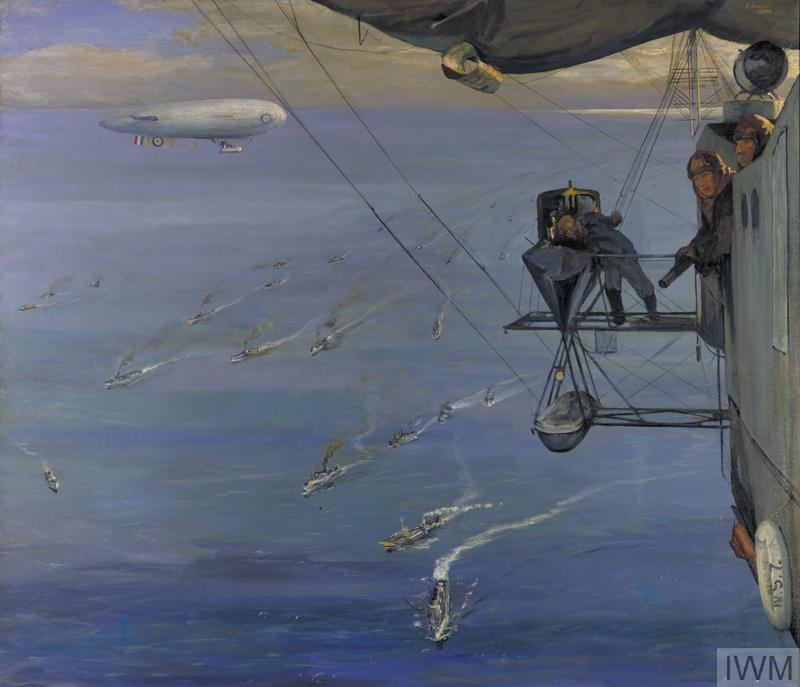
A Convoy, North Sea 1918, Painted from an Airship off the coast of Norway. John Lavery © IWM.
Early in World War 1 transportation of troops to the theatres of war was a priority and naval convoys from Britain and the Empire became of prime importance. The first convoy of thirty-eight troopships from Australia with 21,500 men and ten transports from New Zealand with 8,500 men plus 12,000 horses and military and medical equipment left Australia for Europe in December 1914.
Another priority was to protect merchant shipping from the major threat from German U-Boats. The mercantile fleets maintained the vital supply of personnel, food and goods to Britain from overseas throughout the war. In the initial stages of the conflict, U-Boats would give warning of an intention to attack which allowed passengers and crew time to abandon ship but ultimately Germany used unrestricted warfare in the north-western Atlantic.
The ‘sink on sight’ policy, introduced in February 1917 resulted in a rapid increase in losses of 10% of merchant ships, their crews and their cargoes. In Falmouth, described as ‘the first and last port’, for example at the height of the crisis, in one night one hundred and fifty men were brought ashore and as many as three crews were rescued in one day. A solution was a necessity against the submarine menace and this led to the ‘convoy controversy.
According to the War Cabinet Papers at the National Archives, the Prime Minister David Lloyd George pressed for the use of convoys at a War Cabinet meeting on 23 April. The measure was resisted by the First Sea Lord who was instructed to prepare a report on reducing the submarine menace for the next meeting but in that report there was no mention of a convoy solution to the problem. It was decided by the Cabinet on 25 April that the Prime Minister would visit the Admiralty on 30 April to make a personal investigation. However, before the visit took place the Admiralty decided to give the convoy solution a trial. As a result of the large-scale introduction of convoys from June losses decreased rapidly to less than 1%.
Various ports were designated for rendezvous where vessels gathered before setting out to sea in convoy depending on their destination. From August 1917 Falmouth Bay was a major rendezvous for vessels awaiting convoy across the North Atlantic and through the Mediterranean. During the latter part of the War fifty-eight ocean convoys left Falmouth with convoys leaving every eight days. A French convoy also left weekly taking coal supplies to France in a variety of steam and sailing vessels.
Protection from U-Boats was afforded to convoys by the concept of ‘safety in numbers’ and the presence of armed escort vessels but other methods of deterring torpedo attacks from submarines were employed. One method was to use zig zagging and another was the use of dazzle camouflage.
The zig zag method involved periodically altering course from port to starboard to disguise the true course of a convoy. The process could be dangerous and unless carefully monitored risked collisions between ships leading to damage to vessels and loss of life. The procedure was proscribed by the Admiralty in 1917 and zig zag diagrams were issued to convoys by the Admiralty’s anti-submarine experts. Zig zag clocks were kept on the bridge of each ship in a convoy and synchronised with the overall command ship of the escorts. An alarm was sounded on all the clocks when a course change became due.

A British Convoy Steering a Zig Zag Course in a Danger Zone in WW1. © IWM.
The purpose of dazzle camouflage is one of optical confusion using paint and pattern to confuse and mislead the enemy and was used at sea to deflect torpedo attacks. It was impossible to hide vessels at sea but a solution was made possible by using the idea of dazzle. By using paint and shapes, causing distortion to the perspective and size of ships, the view of a submariner aiming a torpedo through a periscope would be confused.
The concept of dazzling was championed by Norman Wilkinson, the marine artist, and an officer in the Royal Naval Reserve who had served in the Dardanelles. He headed the Naval Camouflage unit set up in the basement of the Royal Academy in London. The unit devised dazzle schemes for individual ships which were each given a unique profile of colours and shapes. Naval Dock Officers were appointed to supervise the painting of ships in ports around Britain. By 1918 over 2,300 merchant ships and warships had been dazzled. Although the scheme’s effectiveness as a deterrent was never conclusive the Admiralty Committee on Dazzle Painting which reported in 1918 did conclude that it led to the greater confidence and morale amongst crews of dazzle ships.
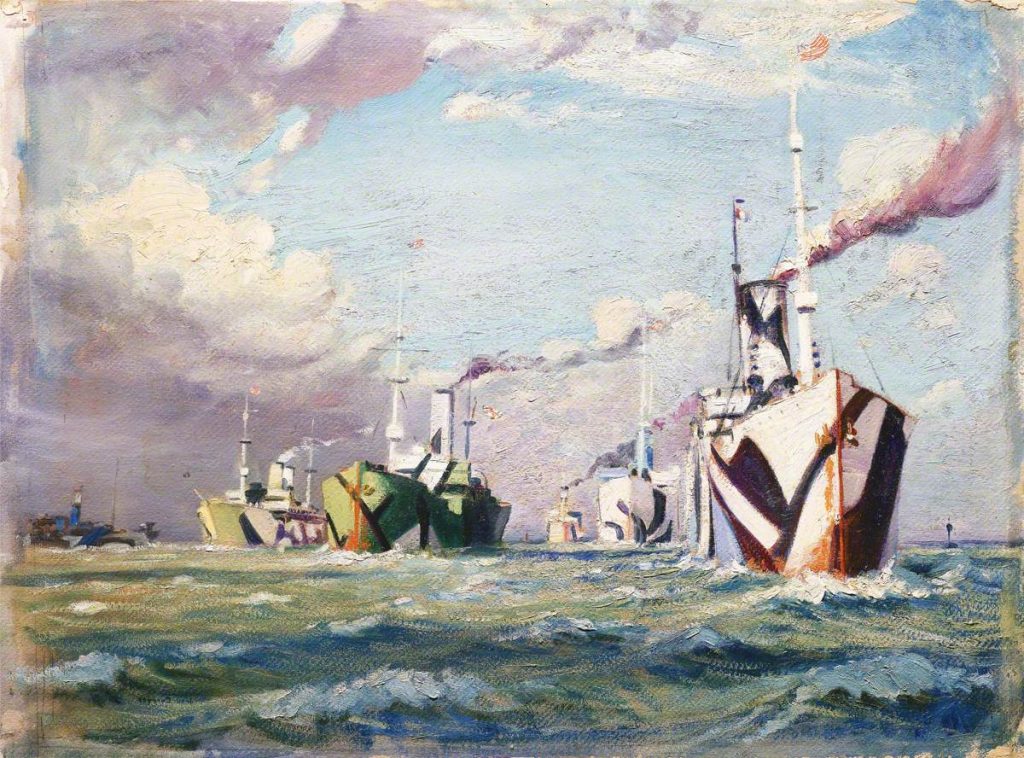
Dazzle Ships in Convoy 1918 John Everett (1876 – 1944) © NMM.
Convoys once again became imperative to Britain’s survival and ability to fight during World War Two to keep supply and communication lines open. On the Declaration of War with Germany merchant shipping was taken under Admiralty control on 26 August 1939 and the first convoy sailed on 2 September. This began the Battle of the Atlantic, a naval battle which lasted from the outbreak of war to the German surrender in 1945. Survival was reliant on convoys of merchant ships to and from Britain to maintain allied supply lines to Britain which Germany and the Axis powers tried to destroy.
Convoys were used to provide protection for the passage or evacuation of personnel, for troop transportation and to keep Britain and her allies supplied with equipment, materials and food. The threat to ships heading to and from Britain was from enemy submarines and warships operating in the world’s oceans and methods of deterrence used during the 1914-1918 conflict were reemployed. Convoys were escorted by armed warships with confusion methods adopted such as zig zag coursing and dazzle camouflage, in more limited form. Development of air support, radar and the breaking of the German Enigma Code for submarines at Bletchley Park were all important in the eventual success of the convoy method in keeping the sea lanes open throughout the conflict.

Officers Of a Convoy Escort in The Atlantic, On Watch for Enemy Attack in 1941 © IWM.
There were many convoys during World War 2 posing danger for all vessels and crews involved and from which many lives were lost. Some of the most difficult were the Arctic Convoys. Between August 1941 and May 1945 seventy- eight convoys delivered essential supplies to the northern ports of the Soviet Union such as Archangel and Murmansk. Escorted by the Royal Navy, the Royal Canadian Navy and the United States Navy the convoys of merchant ships left from the United Kingdom, Iceland and North America usually following the direct but most dangerous Arctic route.
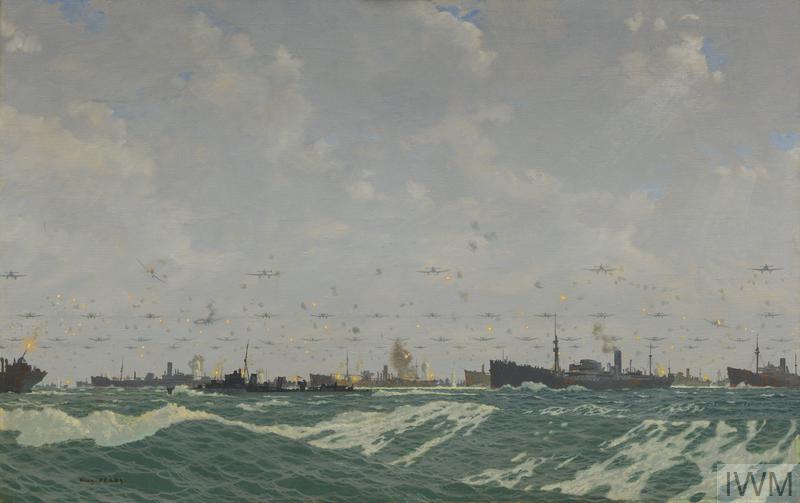
A British Convoy on Its Way to Russia. Charles Pears (1873 – 1958). © IWM.
The danger came not only from attack but the conditions as convoys had to pass close to enemy bases in Norway and had to face the ice pack together with the cold and gales. These were some of the most hazardous and difficult convoy missions and resulted in the highest loss rate of vessels and crews. For example of the thirty-four merchant vessels of Convoy PQ17 pictured below only eleven vessels reached the Soviet Union. The valuable work of the Arctic convoys has now finally been recognized alongside the other campaigns with the award of the Arctic Star Medal to all ranks who served in such convoys.

Convoy PQ17 Assembles in Hvalfjord, Iceland June 1940 RN Official Photographer Lt C J Ware © IWM.
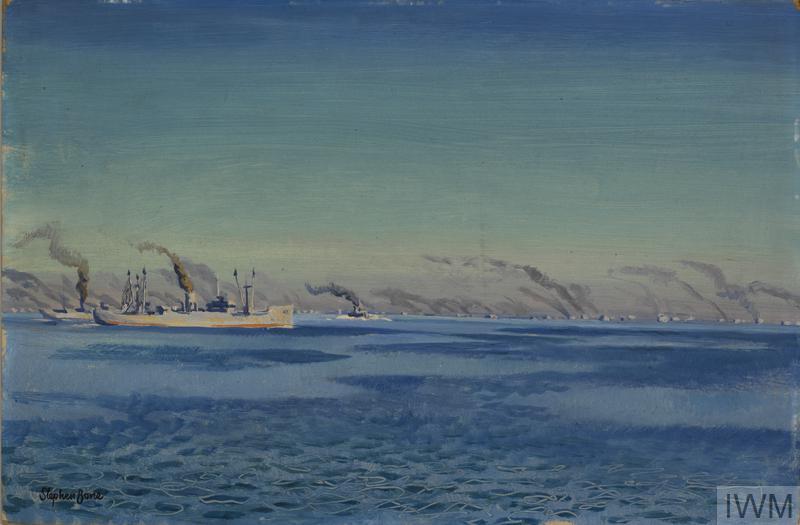
The Rendezvous. Stephen Bone. Second World War Collection © IWM.
The employment of naval convoys has been an important strategy for protecting ships during the centuries. The use of convoys reached a zenith in both World Wars, but that use has continued to be valuable in many more recent situations throughout the world. It has protected shipping from modern pirates off the Somalian coast, kept open grain supply lines from Ukraine and rendered aid and evacuation in disaster situations. The concept of convoys is a matter of naval strategy and tactics but is also an essential element in maintaining the safety of the oceans.
You can read more about dazzle camouflage in our Bartlett Blog here, and discover more about William Broad’s family here.
The Bartlett Blog is written and produced by the volunteers who staff The Bartlett Maritime Research Centre and Library of National Maritime Museum Cornwall. This blog post was written by Linda Batchelor, a Bartlett Library volunteer.
The Bartlett Maritime Research Centre & Library holds a Collection of over 20,000 volumes and offers access to one of the finest collections of maritime reference books, periodicals and archival material. The Bartlett Blog reflects the diversity of material available in The Bartlett Library.

National Maritime
Museum Cornwall Trust
Discovery Quay
Falmouth Cornwall
TR11 3QY
View Map
See our opening hours
Tel: +44(0)1326 313388
Email: enquiries@nmmc.co.uk